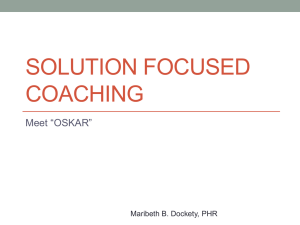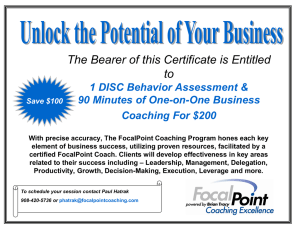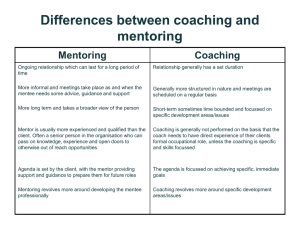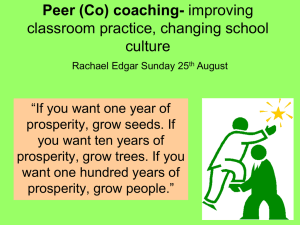Self as instrument in the Coaching Process
advertisement
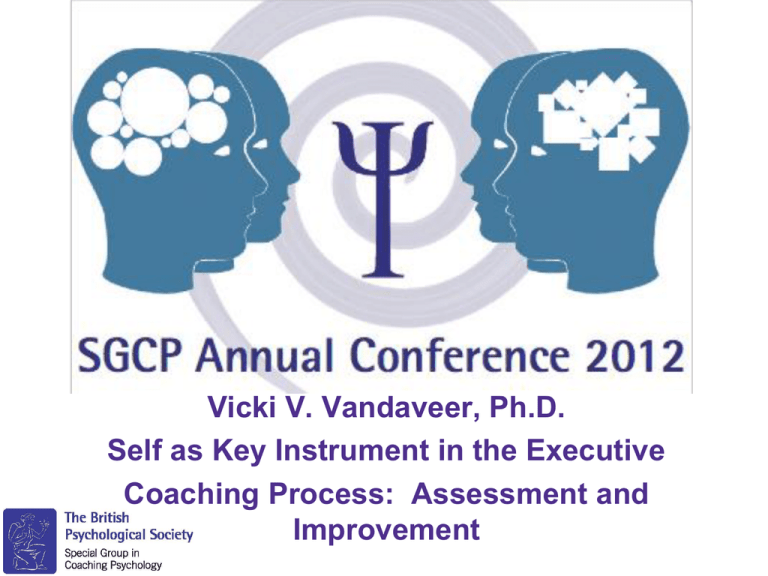
Vicki V. Vandaveer, Ph.D. Self as Key Instrument in the Executive Coaching Process: Assessment and Improvement AGENDA 12:30 – 1:00 INTRODUCTIONS and AGENDA OVERVIEW 1:00 - 1:15 SELF AS INSTRUMENT – The Concept 1:15 – 1:45 SELF ASSESSMENT • A few measures as examples 1:45 – 3:00 CASE STUDY 3:00 – 3:15 BREAK (or when everyone else breaks) 3:15 – 4:00 Self Assessment 4:00 – 5:00 Coaching and Peer Feedback 5:00 – 5:20 Debrief / Discussion 5:20 – 5:30 Wrap up 2 © Vandaveer DEFINITIONS SELF Your entire being. Examples . . . Knowledge Skills Values Needs Motives / motivations Personality Beliefs learning from Experiences Intentions “A means of pursuing an aim” (Oxford Dictionary) INSTRUMENT “A means whereby something is achieved, performed, or furthered” (Webster Dictionary) “A measurement device” (Oxford, Webster Dictionaries) 3 © Vandaveer “Self as Instrument” in the Coaching Process – The Concept Georgetown University – Certificate in Leadership Coaching Emphasizes skill development on 3 levels: Learning about self as a coach and instrument of change Creating productive and fulfilling relationships in the coaching role Understanding coaching within systems dynamics Gestalt Institute of Cleveland (GIC) – International Coaching Program “The Gestalt coach is trained to A)Use self as instrument B)Provide a presence that is otherwise lacking in the system C)Help the client to complete units of work that result in new insights, behavior or action.” 4 © Vandaveer EFFECTIVE COACH ATTRIBUTES, ACTIONS and BEHAVIOURS – from the Literature ATTRIBUTES LISTENING Whitmore (1996) ACTIONS / BEHAVIOURS Command Respect INTUITION Work Collaboratively CURIOSITY Use discursive approach (vs instructive) ACTION/LEARNING Act authentically SELF MANAGEMENT EMOTIONAL INTELLIGENCE Honest, challenging feedback Cox & Bachkirova (2007) [Awareness – own and coachee’s emotions & Context in which occur] Clear objectives Hall, Otazo & Hollenbeck (1999) Good action ideas No personal agenda Accessible, available COMPETENCE, SOPHISTICATION Hall, Otazo & Hollenbeck (1999) KNOWLEDGE – DEVELOPMENT Laske (2007) SKILL – Eliciting Frame of Reference Gonzalez (2004) 5 © Vandaveer EFFECTIVE COACH ATTRIBUTES, ACTIONS and BEHAVIOURS – from the Lierature (Continued) ATTRIBUTES Ability – Suspend Judgment Stelter, R. (2007) ACTIONS / BEHAVIOURS Forms strong connection, support Awareness – PersonSituation Interaction Professional demeanor, behaviour Skill – facilitating coachee’s interpreting & understanding his subjective reality Clear coaching methodology Wasylyshyn, K. (2003) Skill – facilitating ‘meaning making’ – social construction of reality RELATIONSHIP Transparency Gyllensten and Palmer (2007) Trustworthiness 6 © Vandaveer Coach ROLE x Your Coaching COMPETENCIES [Diagram for illustrative purposes only] KNOWLEDGE • Psychology • Org Dynamics • Business • Psychometrics Aspects of your Strengths / Attributes that are not required or not desired in Role SKILLS • Listening / Communication • Facilitation • Assessment • Emotional Intelligence Mod-Hi “Stretch” aspects of Role (draws on areas not your strengths) ROLE – Coaching Psychologist SELF (You) “Sweet Spot”- aspects of Role that play to YOUR current Strengths © Vandaveer SELF IN ROLE AS COACH [Diagram for illustrative purposes only] OPPORTUNITIES FOR DEVELOPMENT, GROWTH, IMPROVEMENT SELF CLIENT ASSESS: Outcomes Client Feedback Colleague Feedback Re-Assess / Continual Improvement ROLE 8 © Vandaveer CASE STUDY MVPI - Motives, Values, Preferences Inventory / Profiles: Coachee, Coaching Psychologist (CP) RECOGNITION POWER HEDONISM ALTRUISM AFFILIATION TRADITION SECURITY COMMERCE AESTHETICS SCIENCE Percentile – Managers 10 COACHEE 20 30 40 50 ⏏ 60 70 80 90 100 CP © Vandaveer MVPI (Motives, Values, Preferences Inventory / Dimensions and Definitions Recognitio n Responsive to attention, approval and praise Power Desire for success, accomplishment, status and control Hedonism Orientation for fun, pleasure, and enjoyment Altruism Desire to help others and contribute to society Affiliation Desire for and enjoyment of social interaction Tradition Dedication, strong personal beliefs, and obligation Security Need for predictability, structure and order Commerce Interest in money, profits, investment and business opportunities Aesthetics Need for self expression; concern over look, feel & design of work products Science Quest for knowledge, research, technology and data © Vandaveer CASE STUDY GPPI - Gordon Personal Profile Inventory ASCENDANCE RESPONSIBILITY EMOTIONAL STABILITY SOCIABILITY CAUTIOUSNESS ORIGINAL THINKING PERSONAL RELATIONS VIGOR SELF CONFIDENCE Percentile – Managers 10 COACHEE 20 30 40 50 ⏏ 60 70 80 90 100 CP © Vandaveer GPPI - Gordon Personal Profile Inventory* - Dimensions HIGH Scorers LOW Scorers • Verbally ascendant • Take an active role in a group • Tend – independent decisions • Self-assured in relationships w/ others • Take passive role in a group • Listen much more than talk • Lack self-confidence • Let others take the lead • May be overly dependent on others • Able to stick to the job • Persevering and determined • Reliable – can be counted on • Have difficulty sticking to tasks that do not interest them • Tend to be irresponsible, “flighty” Emotional Stability • Emotionally stable; relatively free from worries, anxiety • Tend to be anxious, hypersensitive • Have low frustration tolerance Sociability • Like to be with and work with people • Gregarious, sociable • Not gregarious; general restriction in social contacts • (Very low) Avoidance of social relationships • High cautious; carefully consider before making decisions • Do not like to take chances, run risks • Impulsive; act on spur of moment • Make hurried or snap decisions • Enjoy taking chances; seek excitement Ascendance (Social Boldness) Responsibility Cautiousness * GPPI Manual © Vandaveer GPPI - Gordon Personal Profile Inventory* - Dimensions (Continued) HIGH Scorers LOW Scorers Original Thinking • Like to work on difficult problems • Intellectually curious • Enjoy thought-provoking questions & discussions • Like to think about new ideas • Dislike working on difficult or complicated problems • Do not care particularly about thinking about new ideas • Not interested in thoughtprovoking questions & discussions Personal Relations • Have faith and trust in people • Tolerant, patient, understanding • Lack trust or confidence in people • Tend to be critical of others – become annoyed or irritated by what others do • Energetic • Like to work and move rapidly • Able to accomplish more than the average person • Low energy • Prefer setting a slower pace • Tend to tire easily • Tend to be below average in productivity Vigor (Energy) Self Esteem * GPPI Manual Extent to which one feels positive about oneself © Vandaveer CASE STUDY TKI (Thomas Kilmann Conflict Mode Inventory) / Profiles: Coachee and Coaching Psychologist (CP) COMPETING Assertive and uncooperative, a power-oriented mode; ‘win’ COLLABORATING Both assertive and cooperative – try meet needs of both parties COMPROMISING Intermediate assertive + cooperative – try for mutually acceptable solution – partially satisfy both AVOIDING Unassertive, uncooperative – conflict not addressed, or side-stepped ACCOMMODATING Unassertive + cooperative – neglects own concerns to satisfy the other’s concerns Percentile – Managers 10 COACHEE 20 30 40 50 ⏏ 60 70 80 90 100 CP © Vandaveer TKI (Thomas Kilmann Conflict Mode Inventory) / Dimensions – further descriptions COMPETING COLLABORATING COMPROMISING AVOIDING ACCOMMODATING Assertive and uncooperative, a power-oriented mode. When competing, an individual pursues his or her own concerns at the other person’s expense, using whatever power seems appropriate to win his or her position. Competing might mean standing up for your rights, defending a position you believe is correct, or simply trying to win. Both assertive and cooperative. When collaborating, an individual attempts to work with the other person to find a solution that fully satisfies the concerns of both . . . . Involves digging into an issue to identify the underlying concerns of the two individuals and to find an alternative that meets both sets of concerns. Collaborating might take the form of exploring a disagreement to learn from each other’s insights, resolving some condition that would otherwise have them competing for resources, or confronting and trying to find a creative solution to an interpersonal problem. Intermediate in both assertiveness and cooperativeness. When compromising, an individual has the objective of finding an expedient, mutually acceptable solution that partially satisfies both parties. Compromising falls on a middle ground between competing and accommodating, giving up more than competing but less than accommodating. Likewise, it addresses an issue more directly than avoiding but doesn’t explore it in as much depth as collaborating. Compromising might mean splitting the difference, exchanging concessions, or seeking a quick middle-ground position. Unassertive and uncooperative. When avoiding, an individual does not immediately pursue his or her own concerns or those of the other person. He or she does not address the conflict. Avoiding might take the form of diplomatically sidestepping an issue, postponing an issue until a better time, or simply withdrawing from a threatening situation. Unassertive and cooperative—the opposite of competing. When accommodating, an individual neglects his or her own concerns to satisfy the concerns of the other person; there is an element of self-sacrifice in this mode. Accommodating might take the form of selfless generosity or charity, obeying another person’s order when you would prefer not to, or yielding to another’s point of view. MBTI – Myers Briggs Type Indicator EXTRAVERSION INTROVERSION SENSING NTUITION THINKING FEELING JUDGING PERCEIVING 30 25 20 15 10 5 CLIENT COACH 0 5 10 15 20 25 30 16 © Vandaveer FIRO-B – (Fundamental Interpersonal Relations Orientation – Behavior) / PROFILE COMPARISONS CLIENT COACH INCLUSION CONTROL AFFECTION E 2 8 3 13 W 1 1 2 4 3 9 5 17 INCLUSION CONTROL AFFECTION E 5 5 5 15 W 5 5 5 15 10 10 10 30 © Vandaveer FIRO-B (Fundamental Interpersonal Relations Orientation – Behavior) / OVERVIEW • Interpersonal NEEDS underlie interpersonal behavior • Many interpersonal behaviors are “automatic” • Interpersonal behaviors affect individual effectiveness and team dynamics • Interpersonal needs measured: Inclusion, Control, Affection – Inclusion: the need to be around others – involved, included – Control: the need for influence, decision making, responsibility, being in charge – Affection: the need for close interpersonal relationships / warmth / support with others Cell Score: 1-3 = Low; 4-6 = Medium; 7-9 = High © Vandaveer Behaviors Associated with the Three Needs INCLUSION (I) Expressed E Wanted W CONTROL (C) AFFECTION (A) •Inviting others to join in your activities •Assuming positions of authority •Involving others in projects and meetings •Incorporating everyone’s ideas and suggestions •Managing the conversation •Attempting to influence others’ opinions •Taking a personal interest in others •Establishing policies and procedures •Reassuring and supporting others •Showing concern about others’ personal lives •Sharing your personal opinions and feelings •Being trustworthy and loyal •Getting involved in high-profile activities and projects •Asking for help on a job •Being flexible and accommodating •Raising issues for others to consider •Involving others in decisions •Listening carefully to others •Doing things that get noticed •Going along with the majority opinion •Wearing distinctive clothing •Meeting the wishes, needs, and requests of others Hammer, Allen L., with Schnell, Eugene R. FIRO-B Technical Guide. Palo Alto: Consulting Psychologists Press, 2000. •Trying to please others •Making yourself available to others 19 © Vandaveer FIRO-B Score Range 0-15 16-26 27-38 39-54 - Interpretation of Overall Need Score Category Meaning Low • • • • • Low- • Involvement with others is sometimes a source of satisfaction, depending on the people and the context • Work most effectively alone, but can work with others when objectives are focused • Tend to have a small circle of friends Medium Med-High High Involvement with others is not a primary source of need satisfaction Other needs (e.g., intellectual stimulation, solitary pursuits) predominate Tend to need privacy to do their best work Prefer to keep to themselves; tend to have a small circle of friends Highly selective about how often and with whom they interact • Involvement is usually a source of satisfaction • May enjoy small-group work settings • Tend to have a larger group of friends and may contact them on a regular basis • Involvement with others is enjoyable and satisfying • Engage in interpersonal interaction with many people and on a frequent basis Hammer, Allen L., with Schnell, Eugene R. FIRO-B Technical Guide. Palo Alto: Consulting Psychologists Press, 2000. © Vandaveer CASE STUDY JOHN • Country Manager – Central & Southern Africa / American Global Mfg Co. American expatriate – 55 yrs old Financially well off Married – second time 2 yrs ago; ‘trophy’ wife 36 years old; 1 yr old son • SETTING Company restructured – geographical (60+ countries) to functional John selected (with reservations) – VP Global Marketing . . . Reporting to President Moved to Corporate Headquarters – Hong Kong Six months after reorganization – President engaged coaching psychologist to work with him. Behavior must change, or he would be fired. ©Vandaveer CASE STUDY JOHN: Available Existing Data PERFORMANCE REVIEW (First step in disciplinary process) “The following behaviors must improve immediately and improvement sustained – or employment will be terminated” - Arrogant, condescending behaviours; showing disrespect to Senior Management - “Torpedo e-mails” - Public criticism of direct reports 360 FEEDBACK STRENGTHS -- Superior intellect -- Execution -- Knowledge base – the industry, marketing, geo-political . . . -- Innovative thinking -- Decisive -- Articulate -- Outstanding reputation / credibility with Gov’ts, Partners, industry, competition -- Charming (when he wants to be) -- Wit, humor -- Integrity -- Energy IMPROVEMENT NEEDS -- Acting arrogant, egotistical -- Colonial leadership style -- E-mail assassination of senior execs when you disagree -- Cutting down your own team publicly -- Devaluing people and viewing everyone else as incompetent -- Taking a “king of the castle” approach – last word on contentious issues -- Shutting people down -- Being inconsistent – friendly, engaging . . . to . . . dismissive or belittling -- Stifling your direct reports; give them room ©Vandaveer to try, fail, develop . . . CASE STUDY JOHN: Initial Meeting – Assessment & ‘Contracting’ Meeting rescheduled 4 times - On his terms - On his turf (Hotel in Kuala Lumpur where he was holding his global management team meeting) Initial meeting - Behavior / demeanor: Cavalier, disingenuous, ‘charming’ - Appeared very surprised at his 360 feedback – and looked amused - Coach determined that John lacked motivation for change. He was “going through the motions” to satisfy his boss. << Case paused here – for workshop participant analysis and discussion >> ©Vandaveer CASE STUDY JOHN: Initial Meeting – Assessment & ‘Contracting’ The rest of the story . . . Meeting rescheduled 4 times - On his terms - On his turf (Hotel in Kuala Lumpur where he was holding his global management team meeting) Initial meeting - Behavior / demeanor: Cavalier, disingenuous, ‘charming’ - Appeared very surprised at his 360 feedback – and looked amused - Coach determined that John lacked motivation for change. He was “going through the motions” to satisfy his boss. After 1 hour of attempting to engage at an authentic level of dialogue, coach told John: “This coaching will be a waste of your and my time – as well as the company’s money. I’m disengaging.” ©Vandaveer CASE STUDY JOHN: Initial Meeting – Assessment & ‘Contracting’ Coach then found “hook” – motivation to change - Seeing that the coach was serious – that she was disengaging before they even got started – John’s entire demeanor changed. - “My wife Elizabeth thinks I’m a star – a hugely successful international executive . . . believes I walk on water. I cannot get fired!” ©Vandaveer CASE STUDY JOHN: The Intervention Critical Success Factors: A. Motivation to Change B. Insight / Awareness C. Ability to Change D. Identification – Internal Enablers / Inhibitors for Change E. Effective Targeting – Highest Leverage Area(s) for focus F. Coach knowledge, skills – including ability to connect with coachee (coach = instrument) G. Courage H. Commitment I. Accountability ©Vandaveer CASE STUDY JOHN: The Intervention: Cognitive-Behavioral Approach Coaching Included: A. Data to inform the process – 1. Perceptual – Company 360 feedback + coach 360 interviews 2. Annual Reviews – Performance; Potential B. Professional Executive Assessment Cognitive ability / agility; Personality; Values; Leadership profile; EI C. Monthly Meetings with Coach a) Work at cognitive level – Reframing (role, responsibilities, role, perceptions, intentions, impact – desired / actual, ‘success’ criteria) b) Surface assumptions; challenge; facilitate thinking; support D. Development of Strategy and Plan E. “Homework’ – designed / tailored reflective exercises F. Coach ongoing assessment / adjustment G. Accountability H. Progress Evaluation at 9 months / 18 months I. Telephone conversations in-between meetings – as helpful ©Vandaveer CASE STUDY JOHN: Outcome deemed “very successful” Everyone (boss, direct reports, Top Management, coach) gave this engagement less than 50-50 chance of being even partly successful. After 4 months of work, all of them had noticed significant change – and were asking the coach what the magic formula was. After 9 months the 360 feedback process was repeated. Results had significantly improved, and responses to open-ended questions were positive . . . a number of people expressing pessimism that he could actually sustain the change, however. At 12 months, John received a big promotion. Coaching continued after that on a quarterly basis for two years. Performance reviews were all positive – and he was ranked “1” (highest) • He began show-casing his team – and working with each one to develop them to their potential. Became a “coach” Leader. • He still calls the coach from time to time – for “reality check”, to test thinking, to analyze scenarios together, and to share successes & disappointments. • Elizabeth thinks he walks on water. ©Vandaveer CASE STUDY JOHN: What Worked • Motivation to change • Authentic connection with Coach – “Tough love” / no-nonsense approach • Candid feedback • Cognitive-Behavioral intervention (cognitive reframing) • Accountability for change (Boss) • Specific goals and measurable outcomes • Individual assessment (helped understand the 360 feedback; helped identify the greatest leverage areas for coaching) • Coaching Strategy and Process © Vandaveer RELEVANT RESEARCH – A few selected references Cox, E. and Bachkirova, T. (2007). “Coaching with emotion: How coaches deal with difficult emotional situations”. . In Palmer, S. and Cavanagh, M. (Eds) . International Coaching Psychology Review. British Psychological Society – Special Group in Coaching Psychology and Australian Psychological Society Ltd – Interest Group in Coaching Psychology (Vol 2, No 2) Gyllensten, K. and Palmer, S. (2007). “The coaching relationship: An interpretative phenomenological analysis”. In Palmer, S. and Cavanagh, M. (Eds) . International Coaching Psychology Review. British Psychological Society – Special Group in Coaching Psychology and Australian Psychological Society Ltd – Interest Group in Coaching Psychology (Vol 2, No 2) Hall, D.T., Otazo, K.L. & Hollenbeck, G.P. (1999). Behind closed doors: What really happens in executive coaching. Organisational Dynamics, 27, 39–53. Kilburg, R. (2004). Trudging towards Dodoville: Conceptual approaches and cases studies in executive coaching. Consulting Psychology Journal: Practice and Research, 56(4) Kilburg, R.R. (Ed.), (Winter, 2005). Executive coaching [Special issue]. Consulting Psychology Journal: Practice and Research, 57(1). Laske, O. (2007). “Contributions of evidence-based developmental coaching to coaching psychology and practice.” . In Palmer, S. and Cavanagh, M. (Eds) . International Coaching Psychology Review. British Psychological Society – Special Group in Coaching Psychology and Australian Psychological Society Ltd – Interest Group in Coaching Psychology (Vol 2, No 2) Laske, O. (1999) An integrated model of develop- mental coaching. Consulting Psychology Journal 51(3), 139–159. Palmer, S. and Cavanagh, M. (2007). International Coaching Psychology Review. British Psychological Society – Special Group in Coaching Psychology and Australian Psychological Society Ltd – Interest Group in Coaching Psychology (Vol 2, No 2) 30 © Vandaveer RELEVANT RESEARCH (Continued) Passmore, J. and Gibbes, C. (2007). “The state of executive coaching research: What does the current literature tell us and what’s next for coaching research?” In Palmer, S. and Cavanagh, M. (Eds) . International Coaching Psychology Review. British Psychological Society – Special Group in Coaching Psychology and Australian Psychological Society Ltd – Interest Group in Coaching Psychology (Vol 2, No 2) Salovey, P. & Mayer, J. (1990). Emotional intelligence. Imagination, Cognition, and Personality, 9, 185–211. Schmid, P. (2001). Comprehension: The art of not knowing. Dialogical and ethical perspectives on empathy as dialogue in personal and person- centred relationships. In S. Haugh & T. Merry (Eds.), Empathy. Llongarron, Ross-on-Wye: PCCS Books. Stelter, R. (2007). “Coaching: A process of personal and social meaning making.” . In Palmer, S. and Cavanagh, M. (Eds) . International Coaching Psychology Review. British Psychological Society – Special Group in Coaching Psychology and Australian Psychological Society Ltd – Interest Group in Coaching Psychology (Vol 2, No 2) Wasylyshyn, K. (2003). Executive coaching: An outcome study. Consulting Psychology Journal: Practice and Research, 55, 94–106. Whitmore (1996). Coaching for performance. London: Nicholas Brealy Publishing. 31 © Vandaveer



